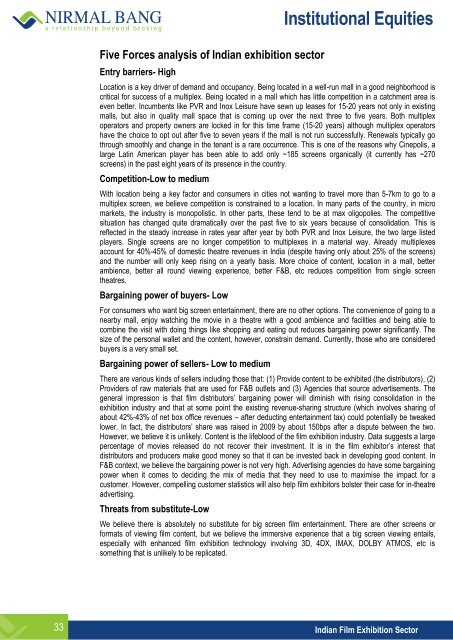Institutional Equities
Indian%20Film%20Exhibition%20Sector-%205%20October%202016
Indian%20Film%20Exhibition%20Sector-%205%20October%202016
Create successful ePaper yourself
Turn your PDF publications into a flip-book with our unique Google optimized e-Paper software.
<strong>Institutional</strong> <strong>Equities</strong><br />
Five Forces analysis of Indian exhibition sector<br />
Entry barriers- High<br />
Location is a key driver of demand and occupancy. Being located in a well-run mall in a good neighborhood is<br />
critical for success of a multiplex. Being located in a mall which has little competition in a catchment area is<br />
even better. Incumbents like PVR and Inox Leisure have sewn up leases for 15-20 years not only in existing<br />
malls, but also in quality mall space that is coming up over the next three to five years. Both multiplex<br />
operators and property owners are locked in for this time frame (15-20 years) although multiplex operators<br />
have the choice to opt out after five to seven years if the mall is not run successfully. Renewals typically go<br />
through smoothly and change in the tenant is a rare occurrence. This is one of the reasons why Cinepolis, a<br />
large Latin American player has been able to add only ~185 screens organically (it currently has ~270<br />
screens) in the past eight years of its presence in the country.<br />
Competition-Low to medium<br />
With location being a key factor and consumers in cities not wanting to travel more than 5-7km to go to a<br />
multiplex screen, we believe competition is constrained to a location. In many parts of the country, in micro<br />
markets, the industry is monopolistic. In other parts, these tend to be at max oligopolies. The competitive<br />
situation has changed quite dramatically over the past five to six years because of consolidation. This is<br />
reflected in the steady increase in rates year after year by both PVR and Inox Leisure, the two large listed<br />
players. Single screens are no longer competition to multiplexes in a material way. Already multiplexes<br />
account for 40%-45% of domestic theatre revenues in India (despite having only about 25% of the screens)<br />
and the number will only keep rising on a yearly basis. More choice of content, location in a mall, better<br />
ambience, better all round viewing experience, better F&B, etc reduces competition from single screen<br />
theatres.<br />
Bargaining power of buyers- Low<br />
For consumers who want big screen entertainment, there are no other options. The convenience of going to a<br />
nearby mall, enjoy watching the movie in a theatre with a good ambience and facilities and being able to<br />
combine the visit with doing things like shopping and eating out reduces bargaining power significantly. The<br />
size of the personal wallet and the content, however, constrain demand. Currently, those who are considered<br />
buyers is a very small set.<br />
Bargaining power of sellers- Low to medium<br />
There are various kinds of sellers including those that: (1) Provide content to be exhibited (the distributors), (2)<br />
Providers of raw materials that are used for F&B outlets and (3) Agencies that source advertisements. The<br />
general impression is that film distributors’ bargaining power will diminish with rising consolidation in the<br />
exhibition industry and that at some point the existing revenue-sharing structure (which involves sharing of<br />
about 42%-43% of net box office revenues – after deducting entertainment tax) could potentially be tweaked<br />
lower. In fact, the distributors’ share was raised in 2009 by about 150bps after a dispute between the two.<br />
However, we believe it is unlikely. Content is the lifeblood of the film exhibition industry. Data suggests a large<br />
percentage of movies released do not recover their investment. It is in the film exhibitor’s interest that<br />
distributors and producers make good money so that it can be invested back in developing good content. In<br />
F&B context, we believe the bargaining power is not very high. Advertising agencies do have some bargaining<br />
power when it comes to deciding the mix of media that they need to use to maximise the impact for a<br />
customer. However, compelling customer statistics will also help film exhibitors bolster their case for in-theatre<br />
advertising.<br />
Threats from substitute-Low<br />
We believe there is absolutely no substitute for big screen film entertainment. There are other screens or<br />
formats of viewing film content, but we believe the immersive experience that a big screen viewing entails,<br />
especially with enhanced film exhibition technology involving 3D, 4DX, IMAX, DOLBY ATMOS, etc is<br />
something that is unlikely to be replicated.<br />
33 Indian Film Exhibition Sector


